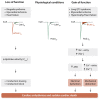Heritable arrhythmia syndromes associated with abnormal cardiac sodium channel function: ionic and non-ionic mechanisms
- PMID: 32251506
- PMCID: PMC7341171
- DOI: 10.1093/cvr/cvaa082
Heritable arrhythmia syndromes associated with abnormal cardiac sodium channel function: ionic and non-ionic mechanisms
Abstract
The cardiac sodium channel NaV1.5, encoded by the SCN5A gene, is responsible for the fast upstroke of the action potential. Mutations in SCN5A may cause sodium channel dysfunction by decreasing peak sodium current, which slows conduction and facilitates reentry-based arrhythmias, and by enhancing late sodium current, which prolongs the action potential and sets the stage for early afterdepolarization and arrhythmias. Yet, some NaV1.5-related disorders, in particular structural abnormalities, cannot be directly or solely explained on the basis of defective NaV1.5 expression or biophysics. An emerging concept that may explain the large disease spectrum associated with SCN5A mutations centres around the multifunctionality of the NaV1.5 complex. In this alternative view, alterations in NaV1.5 affect processes that are independent of its canonical ion-conducting role. We here propose a novel classification of NaV1.5 (dys)function, categorized into (i) direct ionic effects of sodium influx through NaV1.5 on membrane potential and consequent action potential generation, (ii) indirect ionic effects of sodium influx on intracellular homeostasis and signalling, and (iii) non-ionic effects of NaV1.5, independent of sodium influx, through interactions with macromolecular complexes within the different microdomains of the cardiomyocyte. These indirect ionic and non-ionic processes may, acting alone or in concert, contribute significantly to arrhythmogenesis. Hence, further exploration of these multifunctional effects of NaV1.5 is essential for the development of novel preventive and therapeutic strategies.
Keywords: SCN5A; Mechanisms; NaV1.5; Sodium channelopathies; Therapies.
© The Author(s) 2020. Published by Oxford University Press on behalf of the European Society of Cardiology.
Figures




References
-
- Remme CA, Bezzina CR.. Review: sodium channel (dys)function and cardiac arrhythmias. Cardiovasc Ther 2010;28:287–294. - PubMed
-
- Ruan Y, Liu N, Priori SG.. Sodium channel mutations and arrhythmias. Nat Rev Cardiol 2009;6:337–348. - PubMed
-
- Bezzina CR, Rook MB, Groenewegen WA, Herfst LJ, van der Wal AC, Lam J, Jongsma HJ, Wilde AAM, Mannens M.. Compound heterozygosity for mutations (W156X and R225W) in SCN5A associated with severe cardiac conduction disturbances and degenerative changes in the conduction system. Circ Res 2003;92:159–168. - PubMed
-
- Coronel R, Casini S, Koopmann TT, Wilms-Schopman FJG, Verkerk AO, De Groot JR, Bhuiyan Z, Bezzina CR, Veldkamp MW, Linnenbank AC, Van Der Wal AC, Tan HL, Brugada P, Wilde AAM, De Bakker JMT.. Right ventricular fibrosis and conduction delay in a patient with clinical signs of Brugada syndrome: a combined electrophysiological, genetic, histopathologic, and computational study. Circulation 2005;112:2769–2777. - PubMed
-
- Frustaci A, Priori SG, Pieroni M, Chimenti C, Napolitano C, Rivolta I, Sanna T, Bellocci F, Russo MA.. Cardiac histological substrate in patients with clinical phenotype of Brugada syndrome. Circulation 2005;112:3680–3687. - PubMed
Publication types
MeSH terms
Substances
LinkOut - more resources
Full Text Sources
Medical
Miscellaneous

